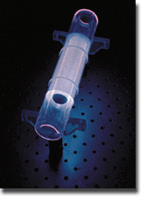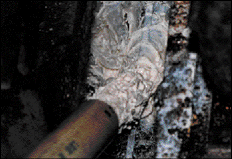Robert C. Pini
Bacteria are not welcome on the metal machining lines at General Motors Corp. But that doesn't stop them from showing up in fluids used to remove metal shavings. To improve on the chemical agents used to control bacteria, GM will purchase a system that uses ultraviolet light to disinfect the water-based fluids cycled continuously down the production line.

|
The UV light source (left) is the heart of the Fastac system that treats opaque metal removal fluids (below) to remove microorganisms.

|
Developed by Triton Thalassic Technologies Inc., the Fastac system is engineered to treat a side stream from the flow of metal-removal fluids that recycles along the machining line where power trains are produced. The side stream flows through the modular UV unit where tolerances in the flow channels allow the light to penetrate the opaque fluids. Microorganisms in the fluids absorb the monochromatic light, which alters their genetic code and sterilizes them.
"You can't get rid of all the microbes," said James D'Arcy, the industrial hygienist at the GM research and development center in Warren, Mich. "The idea is to keep them to a minimum."
Metal-removal fluids are used as coolants and to carry away particles in lathe, grinding and milling processes common to all heavy industry. They quickly become full of bacteria that cause odor, raise health concerns and spoil the fluids.
Chemicals are often used to control microbial growth in the machining fluids. But that raises more health concerns and can create a waste management problem for disposal. "Biocides can be a problem for the people handling them," D'Arcy said. "We would rather not have them in our plant -- these are not nice chemicals." Use of heat and gamma rays or even x-rays was also considered but was discarded in favor of the simpler, safer UV method.
The UV system doesn't degrade the fluid, which saves money and resources. D'Arcy said GM will test the system online at a couple of plants, tracking costs, energy use, maintenance requirements and overall effectiveness before making a final recommendation. "We're a business," he said. "We have to have a cost-effective solution."
Triton Thalassic reports that the system has a two-year return on investment.
